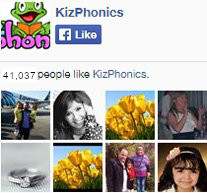Exploring the Magic of Online Stories for Kids: A Journey of Phonics and Imagination
In the realm of children's phonics education, stories are more than mere words on a page—they're portals to adventure, knowledge, and language development. Online stories for kids offer a dynamic avenue to fuse learning with entertainment, enabling young readers to embark on exciting journeys while honing their phonics and reading skills. This article delves into the world of online stories, unveiling how they spark curiosity, enhance phonics understanding, and ignite a lifelong love for reading.
Table of Contents:
Introduction
The Fusion of Learning and Imagination through Online Stories
Navigating the World of Online Stories for Phonics Learning
Benefits of Engaging with Online Stories for Phonics and Reading
Fact Section: FAQs about Online Stories for Kids
Conclusion
Introduction: Where Learning and Adventure Converge
From the moment a child opens a storybook, they step into a world of limitless possibilities. The fusion of narrative and imagination within the pages of a book shapes young minds, fostering language acquisition, cognitive growth, and a passion for storytelling. In the digital age, online stories extend this enchantment to new heights, allowing children to explore phonics, language, and culture through interactive tales.
The Fusion of Learning and Imagination through Online Stories
Online Stories for Kids: Online stories bridge the gap between traditional literacy and the digital era. They provide a multi-sensory experience that captivates children's attention while honing essential reading skills. The marriage of visual elements, narration, and interactive components makes learning engaging and memorable.
Navigating the World of Online Stories for Phonics Learning
As technology evolves, so do the ways in which children engage with stories. Online stories for kids integrate various multimedia elements to create a dynamic reading experience. These elements include:
1. Narration and Audio:
Online stories often come with narration, allowing children to follow along while listening to proper pronunciation and intonation. This enhances their phonemic awareness and auditory discrimination.
2. Interactive Features:
Many online stories incorporate interactive elements. Children can click on words to hear their pronunciation or access definitions, promoting vocabulary development.
3. Animated Visuals:
Animations bring stories to life, captivating young readers' attention and aiding in comprehension. Visual cues enhance their understanding of the narrative.
4. Highlighted Text:
Text that corresponds to the narration is often highlighted, reinforcing the connection between spoken and written words. This feature aids in sight word recognition.
5. Phonics Emphasis:
Some online stories emphasize phonics patterns and letter-sound relationships. This encourages children to decode words and recognize phonetic elements in context.
Benefits of Engaging with Online Stories for Phonics and Reading
1. Phonics Reinforcement:
Online stories integrate phonics concepts seamlessly into narratives. This exposure to phonetic patterns enhances children's ability to decode words and read fluently.
2. Vocabulary Enrichment:
Interactive features and highlighted text introduce children to new words within context. Exposure to a wide range of vocabulary boosts language acquisition.
3. Reading Comprehension:
Interactive elements and animations aid in comprehension. Children grasp the story's plot, characters, and context more effectively.
4. Auditory Discrimination:
Listening to narrations sharpens children's ability to differentiate between sounds, enhancing their phonemic awareness—a fundamental skill for reading.
5. Motivation to Read:
The engaging nature of online stories captivates children's interest, fostering a positive attitude towards reading.
Fact Section: FAQs about Online Stories for Kids
Q1: Are online stories suitable for all age groups?
A1: Yes, online stories can be tailored to different age levels. Younger children may benefit from simple stories with interactive elements, while older children can engage with more complex narratives.
Q2: How can parents ensure online stories are educational?
A2: Choose reputable websites that offer curated collections of online stories. Look for stories that align with educational goals and phonics concepts.
Q3: Can online stories replace traditional storybooks?
A3: Online stories complement traditional reading experiences. Both formats offer unique benefits, and a balance of both can provide a well-rounded literacy journey.
Q4: How often should kids engage with online stories?
A4: Moderation is key. Incorporate online stories into daily routines, but also encourage traditional reading with physical books.
Q5: Are there online story platforms that focus on phonics?
A5: Yes, many educational websites offer online stories with a phonics emphasis. These platforms integrate phonics activities seamlessly into engaging narratives.
Conclusion: Embarking on Digital Reading Adventures
Online stories for kids mark a chapter in the evolution of literacy education. They open the doors to an immersive reading experience that combines technology with the magic of storytelling. As children navigate interactive tales, they cultivate phonics skills, expand their vocabulary, and fuel their imagination. In a world where screens dominate, online stories offer a bridge between learning and technology—a bridge that leads to a world of phonics, reading, and endless possibilities.
To embark on a journey of online storytelling that enhances phonics skills and sparks the love for reading, visit Kizphonics. Here, young readers can uncover a treasure trove of stories that blend education with imagination, creating a fusion of phonics and storytelling magic.











